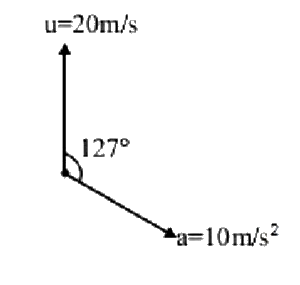For any particle moving with some velocity (→v) & acceleration (→a), tangential acceleration & normal acceleration are defined as follows.
Tangential acceleration - The component of acceleration in the direction of velocity.
Normal acceleration - The component of acceleration in the direction perpendicular to velocity.
If at a given instant, velocity & acceleration of a particle are given by .
→c=4ˆi+3ˆj
vaca=10ˆi+15ˆj+20ˆk
Find the tangential acceleration of the particle at the given instant :-
17(4ˆi+3ˆj)
175(4ˆi+3ˆj)
17(4ˆi−3ˆj)
175(4ˆi−3ˆj)
The correct Answer is:B
To find the tangential acceleration of the particle at the given instant, we will follow these steps:
Step 1: Identify the given vectors
The velocity vector →v and acceleration vector →a are given as:
→v=4^i+3^j
→a=10^i+15^j+20^k
Step 2: Calculate the magnitude of the velocity vector
The magnitude of the velocity vector |→v| is calculated as:
|→v|=√(4)2+(3)2=√16+9=√25=5
Step 3: Calculate the dot product of acceleration and velocity
Next, we need to calculate the dot product →a⋅→v:
→a⋅→v=(10^i+15^j+20^k)⋅(4^i+3^j)
Calculating this gives:
=10⋅4+15⋅3+20⋅0=40+45+0=85
Step 4: Calculate the tangential acceleration
The tangential acceleration at is given by the formula:
at=→a⋅→v|→v|
Substituting the values we calculated:
at=855=17
Step 5: Find the direction of the tangential acceleration
The unit vector in the direction of velocity ^v is:
^v=→v|→v|=4^i+3^j5=45^i+35^j
Thus, the tangential acceleration vector →at is:
→at=at⋅^v=17(45^i+35^j)=685^i+515^j
Final Answer
The tangential acceleration of the particle at the given instant is:
→at=685^i+515^j
---
The velocity vector →v and acceleration vector →a are given as:
→v=4^i+3^j
→a=10^i+15^j+20^k
The magnitude of the velocity vector |→v| is calculated as:
|→v|=√(4)2+(3)2=√16+9=√25=5
Next, we need to calculate the dot product →a⋅→v:
→a⋅→v=(10^i+15^j+20^k)⋅(4^i+3^j)
Calculating this gives:
=10⋅4+15⋅3+20⋅0=40+45+0=85
The tangential acceleration at is given by the formula:
at=→a⋅→v|→v|
Substituting the values we calculated:
at=855=17
The unit vector in the direction of velocity ^v is:
^v=→v|→v|=4^i+3^j5=45^i+35^j
→at=at⋅^v=17(45^i+35^j)=685^i+515^j
The tangential acceleration of the particle at the given instant is:
→at=685^i+515^j
Topper's Solved these Questions
- UNIT & DIMENSIONS, BASIC MATHS AND VECTOR BOOK - ALLENCHAPTER - UNIT & DIMENSIONS, BASIC MATHS AND VECTOR EXERCISE - Exercise (O-1) Matrix match type Questions.
4 Videos
- UNIT & DIMENSIONS, BASIC MATHS AND VECTOR BOOK - ALLENCHAPTER - UNIT & DIMENSIONS, BASIC MATHS AND VECTOR EXERCISE - Exercise (O-2) Single Correct Type Questions.
17 Videos
- UNIT & DIMENSIONS, BASIC MATHS AND VECTOR BOOK - ALLENCHAPTER - UNIT & DIMENSIONS, BASIC MATHS AND VECTOR EXERCISE - Exercise (O-1) ComprehensionType Questions.
3 Videos
- TEST PAPERSBOOK - ALLENCHAPTER - TEST PAPERSEXERCISE - MATHS
18 Videos
- WAVE OPTICSBOOK - ALLENCHAPTER - WAVE OPTICSEXERCISE - Exercise 2 (Previous Year Questions)
7 Videos
Similar Questions
Knowledge Check
For any particle moving with some velocity (→v) & acceleration (→a), tangential acceleration & normal acceleration are defined as follows.
Tangential acceleration - The component of acceleration in the direction of velocity.
Normal acceleration - The component of acceleration in the direction perpendicular to velocity.
If at a given instant, velocity & acceleration of a particle are given by .
→c=4ˆi+3ˆj
→a=10ˆi+15ˆj+20ˆk
Find the normal acceleration of the particles at the given instant :-A−9ˆi+12ˆj+50ˆk5B−9ˆi−12ˆj−50ˆk5C−18ˆi+24ˆj+100ˆk5D18ˆi−24ˆj−100ˆk5If the angle between tangential acceleration and resultant acceleration in non ucm is a, then direction of the resultant acceleration will be
Atan−1(aTar)Btan−1(araT)Ctan−1(araα)Dtan−1(aTaα)At the top of the trajectory of a projectile, the directions of its velocity and acceleration are
APerpendicular to each otherBParallel to each otherCInclined to each other at an angle of 45∘DAntiparallel to each other
Acceleration in circular motion|| Tangential acceleration|| Radial acceleration|| Shape OF path & net Acceleration
View SolutionWhen are the velocity and acceleration in the same direction SHM?
View SolutionIn a two dimensional motion of a body, prove that tangentiol acceleration is nothing but component of acceleration along velocity.
View SolutionIn the figure find the velocity and acceleration of B, if instaneous velocity and acceleration of A are as shown in the Fig.

View SolutionThe instant of time at which acceleration and velocity are perpendicular is :-

View Solution